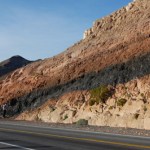united states
News, news, news!
Ash from Eyjafjallajökull piling up on a roof at Seljavellir. Image courtesy of the IMO, by Ari Tryggvason.
The latest from Eyjafjallajökull has the volcano continuing to puff away - producing intermittent airspace closures over Europe. The Icelandic Met Office reports a ~7 km (21,000 foot) ash plume, but they note that the explosivity of the eruption seems to have waned some since a maximum on May 13. Right now, the IMO estimates the eruption rate at ~200 tonnes/second. Lets put that in a little perspective - a Ford F-150 pickup weighs about 2 tonnes, so the volcano is…
Part 2 of your recollections of the May 18, 1980 eruption of Mount St. Helens.
You can read Part 1 here.
You can also check out an amazing set of satellite images spanning 1979-2010 at the NASA Earth Observatory. Great stuff!
-------------------------------------------------------------------------------------------------Eruption plume from Mount St. Helens on May 18, 1980. Image courtesy of the USGS/CVO.
Peter Carlton
My sister and I were playing in our backyard in West Seattle when we heard the boom. I was 6 years old. I remember lots of phone calls with our relatives in Yakima, watching…
Some news for a sleepy Monday:
Mt. Hood in Oregon.
The ash from Eyjafjallajökull is, once again, causing significant airspace closure over northern Europe - close of 1,000 flights today. However, much of the closures are fairly short-lived, but that isn't keeping people happy. The eruption hasn't actually changed much, just that the winds are bringing ash towards Europe. The ash for the next few days will likely effect the England, Scotland, Ireland, Netherlands, France and possibly other parts of northern Europe (along with airspace over Greenland and the north Atlantic). The ash plume is…
May 18, 2010 marks the 30th anniversary of the dramatic eruption of Mount St. Helens in Washington state. Now, rather than recount the event when the USGS and the Cascade Volcano Observatory have done such an excellent job, I turn it over to all the Eruptions readers and their memories of the eruption.
Now, as I've mentioned, I was all of three years old when St. Helens erupted in 1980, so I have no distinct memories of the eruption. My mother has mentioned that she watched the TV coverage with me and my sister, who had been born a two months earlier. However, the real memories of St. Helens…
Time to play a little catch up ...
Eyjafjallajökull erupting in early May. Image by and courtesy of Martin Rietze.
A brief update on our friend Eyjafjallajökull - the eruption plume from the volcano was considerably taller yesterday, reaching 6-9 km (20,000-30,000 feet), but prevailing winds meant the ash hazard was confined to areas in the middle of the North Atlantic and northern parts of the British Isles. However, even as the ash hazard for Europe wanes (for now), you shouldn't forget the amount of ash being dumped on parts of Iceland. If you want to see some stunning images of the…
Mount St. Helens erupting in 1980.
Just a reminder ... please send them to me by May 15 so I can get them all ready for the post on the 18th!
As many of you might (or might not) now, we're heading towards the 30th anniversary of the dramatic eruption of Mount St. Helens in Washington state. Now, I could fill a book with the information out there on the volcano and the eruption, but instead, I think it would be more interesting to get your takes on the eruption. I have to admit, I was all of three when the eruption occurred, so my memories of the event are hazy at best, but if you have any…
Mt. Saint Helens erupting in 2004.
I had a chance to watch a new NOVA special that airs May 5 (PBS) on the 1980-1986 and 2004-2008 eruption cycles at Mt. Saint Helens, along with the recovery of the blast zone from the 1980 eruption. It is a fitting episode as we approach the 30th anniversary of the eruption that took out the north side of the volcano and devastated a vast swath of Cascade wilderness in Washington on May 18, 1980. Many of you have already sent me your Mt. Saint Helens memories (keep them coming!) for my tribute to the eruption, but if you want to get started on remembering…
Mt. Saint Helens erupting in 1980.
As many of you might (or might not) now, we're heading towards the 30th anniversary of the dramatic eruption of Mt. Saint Helens in Washington state. Now, I could fill a book with the information out there on the volcano and the eruption, but instead, I think it would be more interesting to get your takes on the eruption. I have to admit, I was all of three when the eruption occurred, so my memories of the event are hazy at best, but if you have any memories, reactions or thoughts you want to share on the events leading up to the eruption, the eruption…
News!
Colima in Mexico erupting in 2008.
The current activity at Eyjafjallajökull is more-or-less unchanged, with strombolian activity producing a 3-4 km tall ash-and-steam plume and the lava flows at the crater moving northward towards the GÃgjökull glacier. You can check out an extensive page on the state of this eruption at the Nordic Volcanological Center - along with a new page with thermal and LIDAR information on the eruption from France.
The Icelandic Met Office notes that the lava has been producing meltwater from the glacier - which many Eruptions readers have noticed as floods…
Hard to believe, but there is other volcano-related news in the world ...
So, with all deference to Eyjafjallajokull, here it is:
Dome collapse on Colima in Mexico, image taken March 30, 2010.
The new Smithsonian/USGS GVP Weekly Volcano Activity Report was issued, with news about increasing signs of activity at Egon in Indonesia, a possible plume at Miyakejima in Japan and more dome growth at Soufriere Hills.
A study on the economic effect of a new Vesuvius eruption was released and the finding show the potential for a staggering $24 billion of economic damage directly related to an eruption…
Lots to do!
Tourists flock to the Eyjafjallajökull-Fimmvörduháls in Iceland.
The media does love the term "supervolcano", and a number of Eruptions readers sent me a link to the article on the dreaded submarine "supervolcanoes". I would delve into this article from Live Science, but it sadly again does a dreadful job with a lot of this - remember, "supervolcano" is a made-up word by the BBC with no strict definition, so trying to say there are a dozen supervolcanoes worldwide is just silly. And why does it take multiple paragraphs and multiple mentions of "scientists" before they get a…
The steam plume from the new dome on Redoubt, taken in January 2010. Image courtesy of USGS/AVO, taken by Dennis Anderson.
News comes out of Alaska that a small earthquake swarm has begun under Redoubt. This is the second such swarm since the volcano's 2009 activity ceased. Most of the seismicity appears to be near the summit of the volcano, which would suggest that magma might be moving underneath the new dome that is still steaming.
AVO describes the unrest:"This morning, at roughly 01:44 AKDT (0944 UTC) a series of small repetitive earthquakes began occurring in the vicinity of the volcano…
Sunny and 80 here in Ohio today. That could mean only one thing that is likely on everyone's mind. (I suppose there is also this other bit of news that we've been following, too.)
The low, broad shield of Hawai`i's Mauna Loa volcano.
The USGS announced yesterday that inflation at Hawai`i's Mauna Loa appears to have ceased. This prompted the decision to move the alert status at Mauna Loa from "Advisory" to "Normal". This would signify the end of any current activity on the big island's largest volcano - the inflation that had been slowing since 2006 (since 2003 really) finally stopped in…
I'm still playing catch-up after my week in the desert, so I've seen a lot of articles I've wanted to mention ... but a certain other volcano has taken up a lot of my time. However, I will attempt to make amends for that now.
By the way, would you believe Ubehebe Crater was closed? How do they close a volcano, anyway? However, I did get a great snap of a welded tuff on the road outside of Shoshone, CA.
A strongly welded tuff near Shoshone, CA. The dark interior is remelted volcanic ash/tephra surrounded by less welded pink tuff with abundant pumice clasts. Denison student David Sisak is on…
Mt. Baker in the northern Cascades of Washington.
One of the best websites dedicated to any volcano is the Mt. Baker Volcano Research Center - hosted by Western Washington University. I've talked about it before, but David Tucker and his associates have put together an excellent resource on this (at least in my opinion) woefully underappreciated Cascade volcano.
There is a pile of news from the MBVRC and I thought I'd pass it along.
First off, the 2010 T-shirt design contest has kicked off. Last year the MBVRC raised much needed funds with a T-shirt sale and now you can try to design the…
Catching up with some news:
Anatahan erupting in the northern Mariana Islands in 2003.
I ran across this article right before I got sick, but its been popping up around the interwebs (and is pretty interesting). It details a study in Molecular Ecology that suggests that populations of caribou in Canada's Yukon Territory were strongly effected by the White River Tephra. The White River Tephra is supposedly the largest Holocene plinian tephra (from a ash cloud fallout), with two components dating from ~1900 years ago and ~1250 years ago. The vent for the WRT is likely from a vent beneath the…
The Great Earthquake Swarm at Yellowstone that ushered in 2010 seems to be dying down, at least according to the USGS earthquake reports and analysis of the seismicity by the University of Utah and YVO. The daily updates on the earthquake swarms by Utah has ended. Looking at the earthquake over the last 7 days (see below), you can notice three things quickly: (1) since 2/6, there are much fewer quakes compared to a week and a half ago; (2) any sign the earthquakes were getting shallower seems to have ended; and (3) they seem to be generally smaller (the everyday business of being an active…
News!
Pakistan is home to the world's tallest mud volcano in the region of Balochistan - and its somewhat near the reports of an "eruption" earlier this week.
Guess what? Since Wednesday evening, seismicity at Yellowstone has dropped precipitously. The last batch of earthquakes on February 3rd were also back to deeper levels - 8-9 km depth - compared to the potential shallowing earlier in the week. I'm sure the caldera will keep us on our toes, but as of now, it seems to have settled down a bit.
Over in Pakistan, there is mounting evidence that the recent "volcanic" eruption reported as, in…
With all the talk of the current Yellowstone earthquake swarm, I thought it would worth it to write a post on the the structure and caldera - and why we get earthquake swarms that are structurally rather than magmatically-related.
First off, lets think about why calderas formed. This is relatively simple - at least superficially. The land (or volcano) above a magmatic system is partially supported by that magma, especially because magma is hot and buoyant. The isostatic support by the magma holds up the land surface or volcanic edifice, so when an eruption expels a large volume of magma, this…
Steaming, gurgling mudpots in the active hydrothermal system of Yellowstone.
For those of you following Yellowstone (I think there might be a few of you), I've plotted up the earthquakes since 1/27 (see below) - and sure enough, although there is a lot of scatter, they are getting shallower - however what this exactly means is unclear. You can see my plots from 1/22-28 here. As many of you have mentioned, a caldera like Yellowstone is a big interconnected system, so a solely tectonic source of this is still possible as the displacement migrates through the fractured caldera rocks.
UPDATED:…


